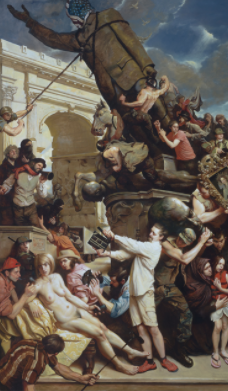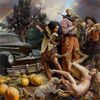Read more
The Fall of Troy Original Painting

The Fall of Troy.
The fall of Troy is told in two of the great works of western literature, honer’sIliad and Virgil's Aeneid. It documents one of the original wars between West and East with a Grecian force setting sail to lay siege to Troy (in modern-day Turkey). While the western Greeks win the war and sack the City leaving ruins in their wake, they also curse themselves. As told by Aeschylus in the Orestes trilogy Agamemnon returns home to be murdered by his wife in revenge for the human sacrifice of his daughter Iphigenia offered up to the gods for a good wind so the Greeks could sail East. Odysseus is lost for 10 years on his way home while his household is beset by suitors looking for his wife’s hand in marriage and despoiling his property. Achilles and Ajax never return home from the war.
This painting is a modern adaption of the fall of Troy. In adapting the story to our times certain key details are kept as is such as the Trojan horse, the sacking of a city and carrying off of treasures. But other details accentuate my own perspective based on living in what I see as a decadent and rapidly degenerating empire. You will notice that the painting and sculptures carried away by the soldiers are icons of western anglo Saxon and classical culture. The portrait is queen Elizabeth and the bust is Augustus. By setting aside their own standards in the name of conquest or progress the modern stand ins for the Greeks have undermined and plundered the foundations of their own culture. In the wake of this destruction, the void is filled by the most basic instincts and the lowest level of the shake as our primal nature is ultimately the one forefront that we cannot eradicate. This is visible in the filming of the nude woman.
The toppling statue is, of course, the iconic sadden Hussein pulled down in Iraq and lying on the pedestal next to it is a fallen Lenin. These are examples of the battles between East and west and references to revolutions eating their own fathers. The central act of pulling down the statues is the ultimately impotent act of the reformer. Iconoclasts attack symbols in their desperation to exist in a world where they can be free of history and their own nature. In the end they never escape the human shadow but the darkness is relieved by fewer works of art. This is evident in history. Most of the art of Greece and Rome is gone. Bronzes melted down and marbles smashed. The idea of empire and conquest endures. And humans still strive for wealth and power.
The Fall of Troy will have its debut on exhibition on November 9th, 2019 at "Not All Doors Are The Same"










0 Reviews